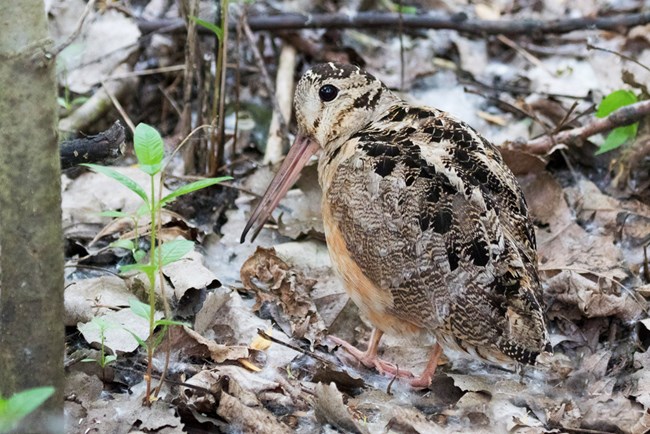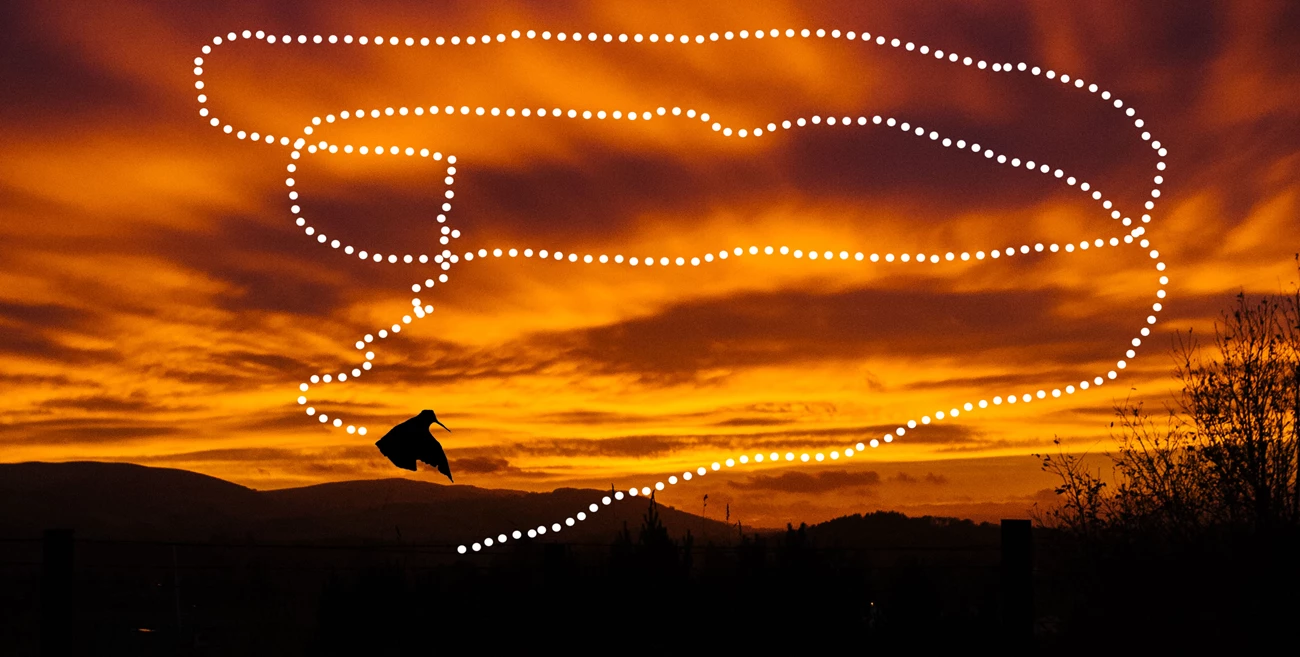Last updated: August 15, 2021
Article
NETN Species Spotlight - American Woodcock


Steve Valasek
What is it?
The American Woodcock is a stout, short-legged shorebird with a long and straight bill. With their large heads and short necks and tails, they have a distinctive bulbous look about them - whether on the ground or in flight. They are closely related to sandpipers but have differing behaviors and are found in other kinds of habitats. Rather than residing along open shorelines, Woodcocks spend their time in young, dense, wet forests near streams, rivers, and marshes. Their specialized long bills are equipped with a prehensile tip, which can be opened to capture prey even when inserted into the ground. Earthworms make up over three-quarters of their diet, but they’ll also snack on other invertebrates like insects, snails, spiders and millipedes.The Woodcock is unique in many ways. Besides the prehensile bill, their large eyes are set further back and higher up on the sides of its head than most other birds. This is likely an adaptation that allows them have a virtual 360 degree view while probing for food. The bird even has an “upside down brain” compared to other birds. The cerebellum, controlling muscle coordination and balance, is set below the rest of the brain and above the spinal column. The theory for this being that as Woodcocks evolved, their eyes moved back in the skull, the bill lengthened and the nostrils approached the base of the bill, allowing for enhanced ground-probing abilities and resulting in the brain being rearranged.
Because of its unique appearance and behaviors, the American Woodcock enjoys some of the most colorful colloquial names for a bird you’ll find, including the “Labrador twister”, “bogsucker”, “mudsnipe”, “hokumpoke”, and the supremely satisfying “timberdoodle”.
A Dazzling Display
Some may say this odd bird isn’t much to see. In fact it can be hard just to see at all most of times of the year. The bogsucker’s mottled russet and brown feather pattern blends in so well with the drab browns of the forest floor, it can make them practically disappear even if you’re standing only a few feet from them. The best time of year to lay eyes on a Woodcock is when it performs its fantastic spring mating ritual - a sure-fire sign that winter is finally loosening its grip on the Northeast.To attract a mate, the male Woodcock performs an elaborate “sky dance” during the last waning light of day. The preferred habitat for this display is a wet marshy area with an open sky above. The ritual starts with a buzzy “peent” call, after which the Labrador twister launches into a high, twisting and looping flight, ascending as high as 300 feet with unique twittering and bubbling sounds. Then the bird goes into a steep dive back to the ground, often landing just inches from where it initially launched. Several birds can be “dancing” nearby each other, and the ceremony is repeated until day fully gives way to night.
If a female is taken in by his charms, she will scrape together a nest directly on the forest floor. After mating the male continues his displaying, taking no part in parental duties. This isn’t an over burdensome chore for the female though, as with most shorebirds, the young are precocious (feathered and active when hatched) and don’t require much parenting. When early May rolls around, they will be able to care for themselves in most cases.

Birds of a Feather
Creating or preserving habitat for timberdoodle has been shown to be an effective way for helping out other birds that share second-growth habitat preference for breeding, including the increasingly rare Golden-winged Warbler. Since it requires consistent management or natural disturbance to keep from growing into mature forest, “early successional” forest habitat continues to shrink in the northeast as forests naturally age. Birds that primarily rely on this habitat are showing some of the steepest declines of all bird species. Audubon’s Breeding Bird Survey revealed that 50 out of 78 early successional habitat species are experiencing the greatest declines of any group dependent on a major habitat type.How are they doing?
The hokumpoke is still fairly numerous, though it can be hard to detect with traditional bird surveys like the North American Breeding Bird Survey or Christmas Bird Count. Estimates are that the population has fallen by an average of slightly more than 1% annually since the 1960s. Declines appear sharpest in most of the NETN region, including New England and parts of the Mid-Atlantic. Woodcocks were included on the American Bird Conservancy’s 2014 State of the Birds Watch List that highlights birds most in danger of extinction without significant conservation action.The Woodcock remains a popular autumn game bird, though it isn’t believed that hunting is a big factor in its declining numbers. As noted earlier, most of this decline is attributed to a loss of habitat caused by forest maturation and urban development.
Woodcocks can also be vulnerable to hazards encountered during migration. Since they are nocturnal migrants and only fly at about 50 feet off the ground, they can collide with communications towers, glass windows, and other man-made structures. Their heavy diet of earthworms also makes them susceptible to poisoning by accumulated pesticides and heavy metals picked up by the worms as they digest soil matter.
For more information
-Listen to fantastic recordings of Woodcock peents and mating rituals:
- See NETN's website for info on the long-term Breeding Landbird monitoring program
Dowload a printable PDf of this article.
Tags
- acadia national park
- eleanor roosevelt national historic site
- home of franklin d roosevelt national historic site
- marsh - billings - rockefeller national historical park
- morristown national historical park
- saint-gaudens national historical park
- salem maritime national historical park
- saratoga national historical park
- saugus iron works national historic site
- vanderbilt mansion national historic site
- weir farm national historical park
- netn
- species spotlight
- birds
- birding
- bird monitoring
- woodcock
- midwest
